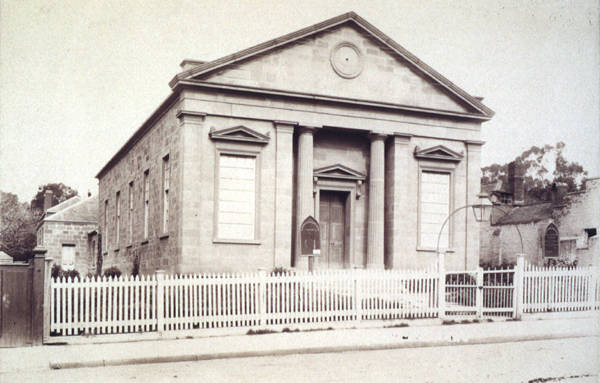 |
 |
|
Presbyterian Church
The Presbyterian Church in Tasmania dates back to the early days of British settlement, with some Presbyterians arriving in 1804. In 1821 Presbyterian settlers of Hobart Town petitioned the Scottish Church for a minister, and the Rev Archibald MacArthur arrived late in 1822. The first Presbyterian service in Australia conducted by an ordained minister was held in Hobart on 5 January 1823, commemorated by a plaque on the Treasury Building, on the site where it was held. The following year, 1824, St Andrew's Church (now hall) was the second Presbyterian Church opened for the public worship of God in Australia. Many Scottish settlers continued to arrive and settled throughout the island, particularly in Bothwell, Campbell Town and Deloraine. In 1835 the Presbytery of Van Diemen's Land was constituted at Launceston, the second Presbytery in Australia. Attention was given to the establishment of Presbyterian congregations, with church buildings erected at various centres on the east coast, midlands and northern Tasmania. Government assistance in land grants, capital costs and ministers' stipends was a hotly contested issue, with the Presbyterian Church finally given assistance as well as the Church of England and the Roman Catholic Church The effects of the 1843 Great Disruption of the Church of Scotland over the question of separation of State and Church were felt in the colony, and a Free Church Presbytery was set up in 1853, 'holding the principles of the Free Church of Scotland'. Free Kirkers erected a Chalmers Church in both Hobart and Launceston, named after their Scottish leader, Thomas Chalmers. The many efforts made to promote union between the two Presbyteries in Tasmania were finally successful in 1896, and the Presbyterian Church of Tasmania embraced all congregations of an undivided Church. In 1901 the Presbyterian Church of Australia was formed whereby the state churches federated yet preserved their separate identities. Tasmania desired closer links with Victoria, and a union was concluded in 1912. The first women's organisation was the Ladies' Benevolent Society, formed in 1840, which was absorbed into the Presbyterian Women's Missionary Union in 1903, now renamed Presbyterian Women of Australia. Presbyterians were active in education, establishing various colleges in Hobart and Launceston, the most successful being Scotch College, Launceston. Homes for the aged were established in Launceston and Hobart. In 1977 the Uniting Church of Australia was formed from the Presbyterian, Methodist and Congregational Churches. Seventy percent of Australian Presbyterian churches voted to join, but the other 30 percent continued as Presbyterian. During the twentieth century the Church had moved away from a strong assertion of its heritage and become quite liberal in its theology. There are now twelve Presbyterian charges and ten ordained ministers in Tasmania. The Church has a camp site on the east coast, and operates retirement homes at Launceston and Legana. Further reading: J Heyer, The Presbyterian pioneers of Van Diemen's Land, Launceston, 193 5; R Miller, Presbyterian Church of Tasmania, Hobart, 1973; R Humphries & R Ward, Religious bodies in Australia, Melbourne, 1988. Ivan Gaggin |
Copyright 2006, Centre for Tasmanian Historical Studies |
